size INFINITI QX50 2021 Owner's Manual
[x] Cancel search | Manufacturer: INFINITI, Model Year: 2021, Model line: QX50, Model: INFINITI QX50 2021Pages: 542, PDF Size: 3.51 MB
Page 23 of 542

FRONT POWER SEAT
ADJUSTMENT
Operating tips
• The power seat motor has an auto-resetoverload protection circuit. If the motor
stops during operation, wait 30 seconds
then reactivate the switch.
• Do not operate the power seat switch for a long period of time when the engine is off.
This will discharge the battery.
For additional information, see “Memory
seat” (P. 3-36).
Forward and backward
Moving the switch as shown will slide the
seat forward or backward to the desired
position.
Reclining
Move the recline switch as shown until the
desired angle is obtained. The reclining feature allows adjustment of
the seatback for occupants of different sizes
for added comfort and to help obtain proper
seat belt fit. For additional information, see
“Precautions on seat belt usage” (P. 1-11).
Also, the seatback can be reclined to allow
occupants to rest when the vehicle is stopped
and the shift lever is in P (Park).
LRS2985
Safety-Seats, seat belts and supplemental restraint system1-3
Page 25 of 542

forward. Release the lever to lock the seat-
back in position.
The recline feature allows adjustment of the
seatback for occupants of different sizes for
added comfort and to help obtain proper seat
belt fit. For additional information, see “Pre-
cautions on seat belt usage” (P. 1-11). Also,
the seatback can be reclined to allow occu-
pants to rest when the vehicle is stopped and
the shift lever is in P (Park).
WARNING
• After adjustment, gently rock in the seat
to make sure it is securely locked.
• Do not ride in a moving vehicle when the
seatback is reclined. This can be danger-
ous. The shoulder belt will not be against
your body. In an accident, you could be
thrown into it and receive neck or other
serious injuries. You could also slide un-
der the lap belt and receive serious inter-
nal injuries.
• For the most effective protection when
the vehicle is in motion, the seat should
be upright. Always sit well back and up-
right in the seat and adjust the seat belt
properly. For additional information, see
“Precautions on seat belt usage”
(P. 1-11).
ARMRESTS
The rear bench seat comes equipped with an
armrest. Pull the armrest down as shown.
FLEXIBLE SEATING
WARNING
• Never allow anyone to ride in the cargo
area or on the rear seats when they are in
the fold-down position. In a collision,
people riding in these areas without
proper restraints are more likely to be
seriously injured or killed. •
Do not allow people to ride in any area of
your vehicle that is not equipped with
seats and seat belts. Be sure everyone in
your vehicle is in a seat and using a seat
belt properly.
• Do not allow more than one person to use
the same seat belt.
• Do not fold down the rear seats when
occupants are in the rear seat area or any
luggage is on the rear seats.
– Make sure that the seat path is clear
before moving the seat.
– Be careful not to allow hands or feet
to get caught or pinched in the seat.
• Head restraints/headrests should be ad-
justed properly as they may provide sig-
nificant protection against injury in an
accident. Always replace and adjust
them properly if they have been removed
for any reason.
• If the head restraints/headrests are re-
moved for any reason, they should be se-
curely stored to prevent them from caus-
ing injury to passengers or damage to the
vehicle in case of sudden braking or an
accident.
LRS2924
Safety-Seats, seat belts and supplemental restraint system1-5
Page 39 of 542
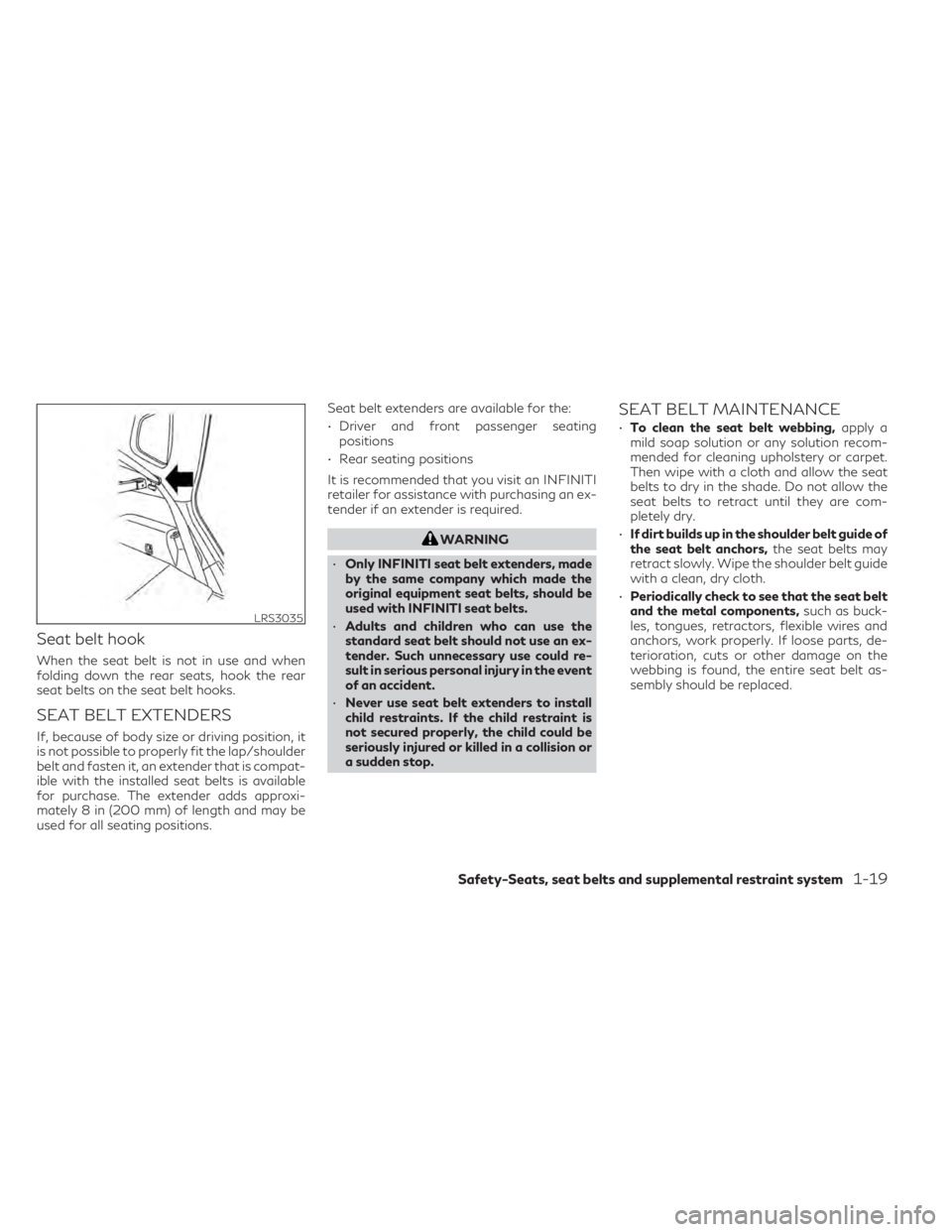
Seat belt hook
When the seat belt is not in use and when
folding down the rear seats, hook the rear
seat belts on the seat belt hooks.
SEAT BELT EXTENDERS
If, because of body size or driving position, it
is not possible to properly fit the lap/shoulder
belt and fasten it, an extender that is compat-
ible with the installed seat belts is available
for purchase. The extender adds approxi-
mately 8 in (200 mm) of length and may be
used for all seating positions.Seat belt extenders are available for the:
• Driver and front passenger seating
positions
• Rear seating positions
It is recommended that you visit an INFINITI
retailer for assistance with purchasing an ex-
tender if an extender is required.
WARNING
• Only INFINITI seat belt extenders, made
by the same company which made the
original equipment seat belts, should be
used with INFINITI seat belts.
• Adults and children who can use the
standard seat belt should not use an ex-
tender. Such unnecessary use could re-
sult in serious personal injury in the event
of an accident.
• Never use seat belt extenders to install
child restraints. If the child restraint is
not secured properly, the child could be
seriously injured or killed in a collision or
a sudden stop.
SEAT BELT MAINTENANCE
• To clean the seat belt webbing, apply a
mild soap solution or any solution recom-
mended for cleaning upholstery or carpet.
Then wipe with a cloth and allow the seat
belts to dry in the shade. Do not allow the
seat belts to retract until they are com-
pletely dry.
• If dirt builds up in the shoulder belt guide of
the seat belt anchors, the seat belts may
retract slowly. Wipe the shoulder belt guide
with a clean, dry cloth.
• Periodically check to see that the seat belt
and the metal components, such as buck-
les, tongues, retractors, flexible wires and
anchors, work properly. If loose parts, de-
terioration, cuts or other damage on the
webbing is found, the entire seat belt as-
sembly should be replaced.
LRS3035
Safety-Seats, seat belts and supplemental restraint system1-19
Page 40 of 542
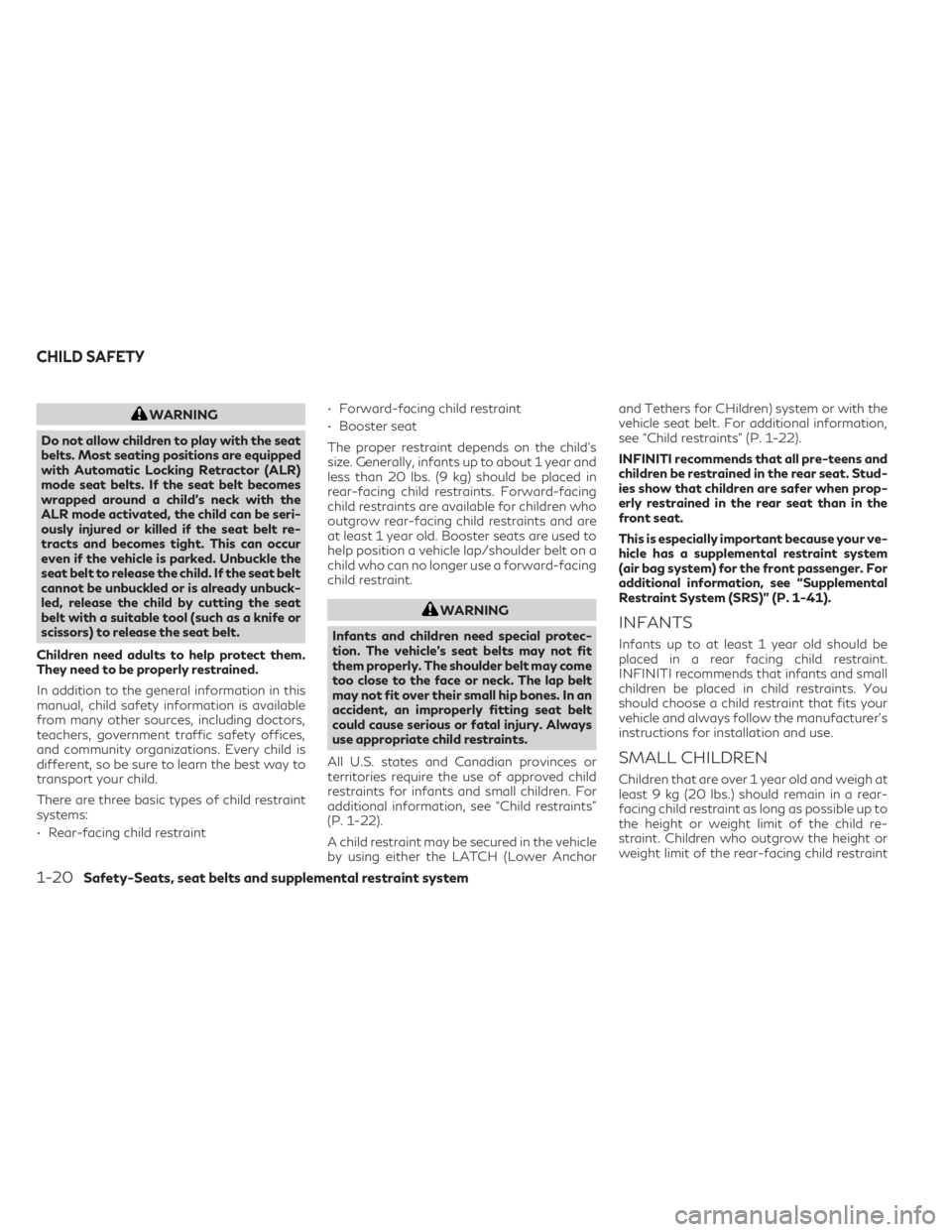
WARNING
Do not allow children to play with the seat
belts. Most seating positions are equipped
with Automatic Locking Retractor (ALR)
mode seat belts. If the seat belt becomes
wrapped around a child’s neck with the
ALR mode activated, the child can be seri-
ously injured or killed if the seat belt re-
tracts and becomes tight. This can occur
even if the vehicle is parked. Unbuckle the
seat belt to release the child. If the seat belt
cannot be unbuckled or is already unbuck-
led, release the child by cutting the seat
belt with a suitable tool (such as a knife or
scissors) to release the seat belt.
Children need adults to help protect them.
They need to be properly restrained.
In addition to the general information in this
manual, child safety information is available
from many other sources, including doctors,
teachers, government traffic safety offices,
and community organizations. Every child is
different, so be sure to learn the best way to
transport your child.
There are three basic types of child restraint
systems:
• Rear-facing child restraint • Forward-facing child restraint
• Booster seat
The proper restraint depends on the child's
size. Generally, infants up to about 1 year and
less than 20 lbs. (9 kg) should be placed in
rear-facing child restraints. Forward-facing
child restraints are available for children who
outgrow rear-facing child restraints and are
at least 1 year old. Booster seats are used to
help position a vehicle lap/shoulder belt on a
child who can no longer use a forward-facing
child restraint.
WARNING
Infants and children need special protec-
tion. The vehicle's seat belts may not fit
them properly. The shoulder belt may come
too close to the face or neck. The lap belt
may not fit over their small hip bones. In an
accident, an improperly fitting seat belt
could cause serious or fatal injury. Always
use appropriate child restraints.
All U.S. states and Canadian provinces or
territories require the use of approved child
restraints for infants and small children. For
additional information, see “Child restraints”
(P. 1-22).
A child restraint may be secured in the vehicle
by using either the LATCH (Lower Anchor and Tethers for CHildren) system or with the
vehicle seat belt. For additional information,
see “Child restraints” (P. 1-22).
INFINITI recommends that all pre-teens and
children be restrained in the rear seat. Stud-
ies show that children are safer when prop-
erly restrained in the rear seat than in the
front seat.
This is especially important because your ve-
hicle has a supplemental restraint system
(air bag system) for the front passenger. For
additional information, see “Supplemental
Restraint System (SRS)” (P. 1-41).INFANTS
Infants up to at least 1 year old should be
placed in a rear facing child restraint.
INFINITI recommends that infants and small
children be placed in child restraints. You
should choose a child restraint that fits your
vehicle and always follow the manufacturer's
instructions for installation and use.
SMALL CHILDREN
Children that are over 1 year old and weigh at
least 9 kg (20 lbs.) should remain in a rear-
facing child restraint as long as possible up to
the height or weight limit of the child re-
straint. Children who outgrow the height or
weight limit of the rear-facing child restraint
CHILD SAFETY
1-20Safety-Seats, seat belts and supplemental restraint system
Page 43 of 542
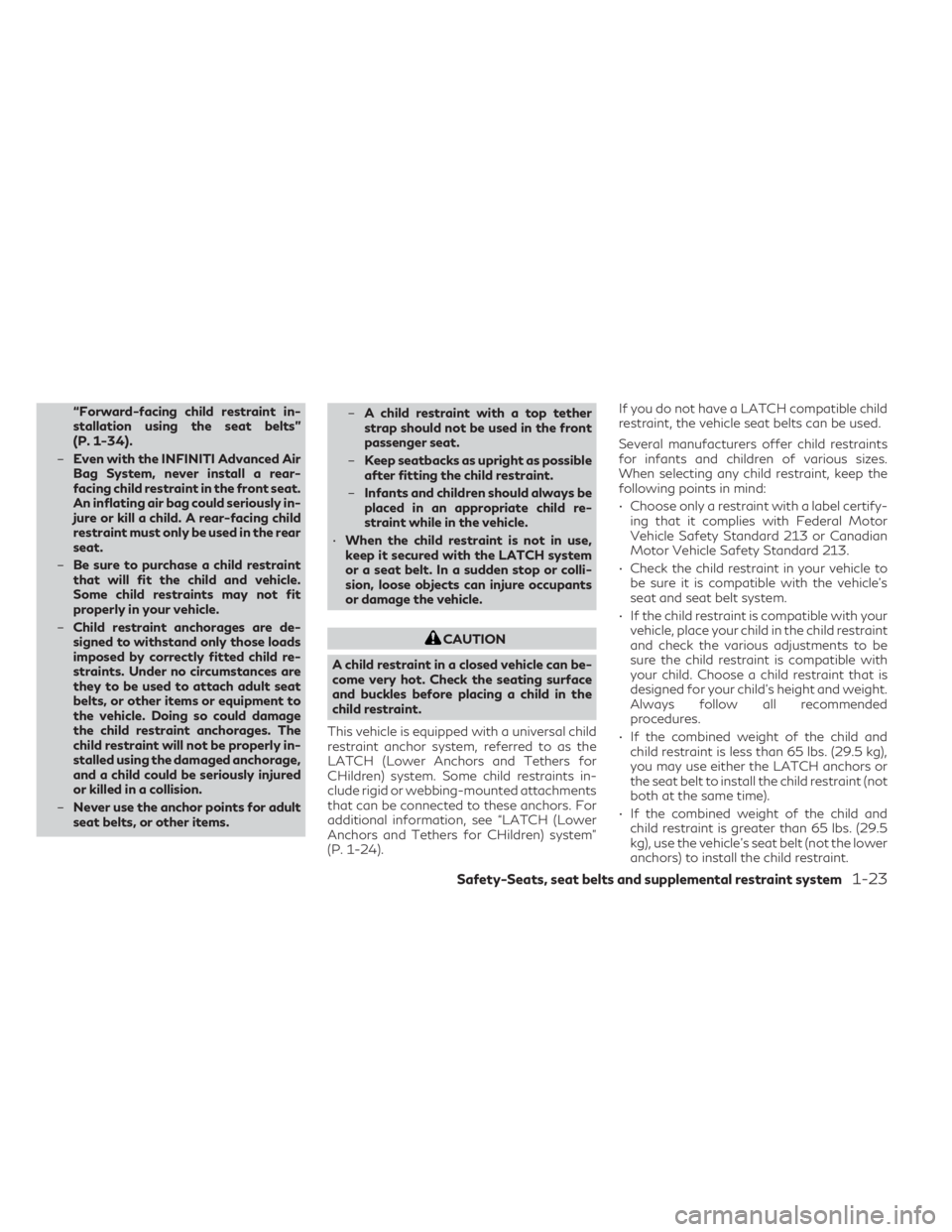
“Forward-facing child restraint in-
stallation using the seat belts”
(P. 1-34).
– Even with the INFINITI Advanced Air
Bag System, never install a rear-
facing child restraint in the front seat.
An inflating air bag could seriously in-
jure or kill a child. A rear-facing child
restraint must only be used in the rear
seat.
– Be sure to purchase a child restraint
that will fit the child and vehicle.
Some child restraints may not fit
properly in your vehicle.
– Child restraint anchorages are de-
signed to withstand only those loads
imposed by correctly fitted child re-
straints. Under no circumstances are
they to be used to attach adult seat
belts, or other items or equipment to
the vehicle. Doing so could damage
the child restraint anchorages. The
child restraint will not be properly in-
stalled using the damaged anchorage,
and a child could be seriously injured
or killed in a collision.
– Never use the anchor points for adult
seat belts, or other items. –
A child restraint with a top tether
strap should not be used in the front
passenger seat.
– Keep seatbacks as upright as possible
after fitting the child restraint.
– Infants and children should always be
placed in an appropriate child re-
straint while in the vehicle.
• When the child restraint is not in use,
keep it secured with the LATCH system
or a seat belt. In a sudden stop or colli-
sion, loose objects can injure occupants
or damage the vehicle.
CAUTION
A child restraint in a closed vehicle can be-
come very hot. Check the seating surface
and buckles before placing a child in the
child restraint.
This vehicle is equipped with a universal child
restraint anchor system, referred to as the
LATCH (Lower Anchors and Tethers for
CHildren) system. Some child restraints in-
clude rigid or webbing-mounted attachments
that can be connected to these anchors. For
additional information, see “LATCH (Lower
Anchors and Tethers for CHildren) system”
(P. 1-24). If you do not have a LATCH compatible child
restraint, the vehicle seat belts can be used.
Several manufacturers offer child restraints
for infants and children of various sizes.
When selecting any child restraint, keep the
following points in mind:
• Choose only a restraint with a label certify-
ing that it complies with Federal Motor
Vehicle Safety Standard 213 or Canadian
Motor Vehicle Safety Standard 213.
• Check the child restraint in your vehicle to be sure it is compatible with the vehicle's
seat and seat belt system.
• If the child restraint is compatible with your vehicle, place your child in the child restraint
and check the various adjustments to be
sure the child restraint is compatible with
your child. Choose a child restraint that is
designed for your child's height and weight.
Always follow all recommended
procedures.
• If the combined weight of the child and child restraint is less than 65 lbs. (29.5 kg),
you may use either the LATCH anchors or
the seat belt to install the child restraint (not
both at the same time).
• If the combined weight of the child and child restraint is greater than 65 lbs. (29.5
kg), use the vehicle's seat belt (not the lower
anchors) to install the child restraint.
Safety-Seats, seat belts and supplemental restraint system1-23
Page 58 of 542

BOOSTER SEATS
For additional information on installing a
booster seat in your vehicle, follow the in-
structions outlined in this section.
Precautions on booster seats
WARNING
If a booster seat and seat belt are not used
properly, the risk of a child being injured or
killed in a sudden stop or collision greatly
increases:
– Make sure the shoulder portion of the
belt is away from the child's face and
neck and the lap portion of the belt does
not cross the stomach.
– Make sure the shoulder belt is not be-
hind the child or under the child's arm.
– A booster seat must only be installed in a
seating position that has a lap/shoulder
belt. Booster seats of various sizes are offered by
several manufacturers. When selecting any
booster seat, keep the following points in
mind:
• Choose only a booster seat with a label
certifying that it complies with Federal Mo-
tor Vehicle Safety Standard 213 or Cana-
dian Motor Vehicle Safety Standard 213.
• Check the booster seat in your vehicle to be sure it is compatible with the vehicle’s seat
and seat belt system. • Make sure the child’s head will be properly
supported by the booster seat or vehicle
seat. The seatback must be at or above the
center of the child’s ears. For example, if a
low back booster seat is chosen, the vehicle
seatback must be at or above the center of
the child’s ears. If the seatback is lower than
the center of the child’s ears, a high back
booster seat should be used.
• If the booster seat is compatible with your vehicle, place the child in the booster seat
and check the various adjustments to be
sure the booster seat is compatible with the
child. Always follow all recommended
procedures.
LRS2479
A. Low back booster seat
B. High back booster seat
LRS0453
1-38Safety-Seats, seat belts and supplemental restraint system
Page 60 of 542

3. The booster seat should be positioned onthe vehicle seat so that it is stable.
If necessary, adjust or remove the head
restraint/headrest to obtain the correct
booster seat fit. If the head restraint/
headrest is removed, store it in a secure
place. Be sure to reinstall the head
restraint/headrest when the booster
seat is removed. For additional informa-
tion, see “Head restraints/headrests”
(P. 1-7). If the seating position does not have an
adjustable head restraint/headrest and it
is interfering with the proper booster seat
fit, try another seating position or a differ-
ent booster seat.
4. Position the lap portion of the seat belt low and snug on the child’s hips. Be sure to
follow the booster seat manufacturer’s
instructions for adjusting the seat belt
routing.
5. Pull the shoulder belt portion of the seat belt toward the retractor to take up extra
slack. Be sure the shoulder belt is posi-
tioned across the top, middle portion of
the child’s shoulder. Be sure to follow the
booster seat manufacturer’s instructions
for adjusting the seat belt routing.
6. Follow the warnings, cautions and in- structions for properly fastening a seat
belt shown in “Three-point type seat belt
with retractor” (P. 1-15). 7. If the booster seat is installed in the front
passenger seat, place the ignition switch
in the ON position. The front passenger air
bag status light
may or may not
illuminate, depending on the size of the
child and the type of booster seat being
used. For additional information, see
“Front passenger air bag and status light”
(P. 1-51).
LRS0454
Front passenger position
LRS0865
1-40Safety-Seats, seat belts and supplemental restraint system
Page 72 of 542
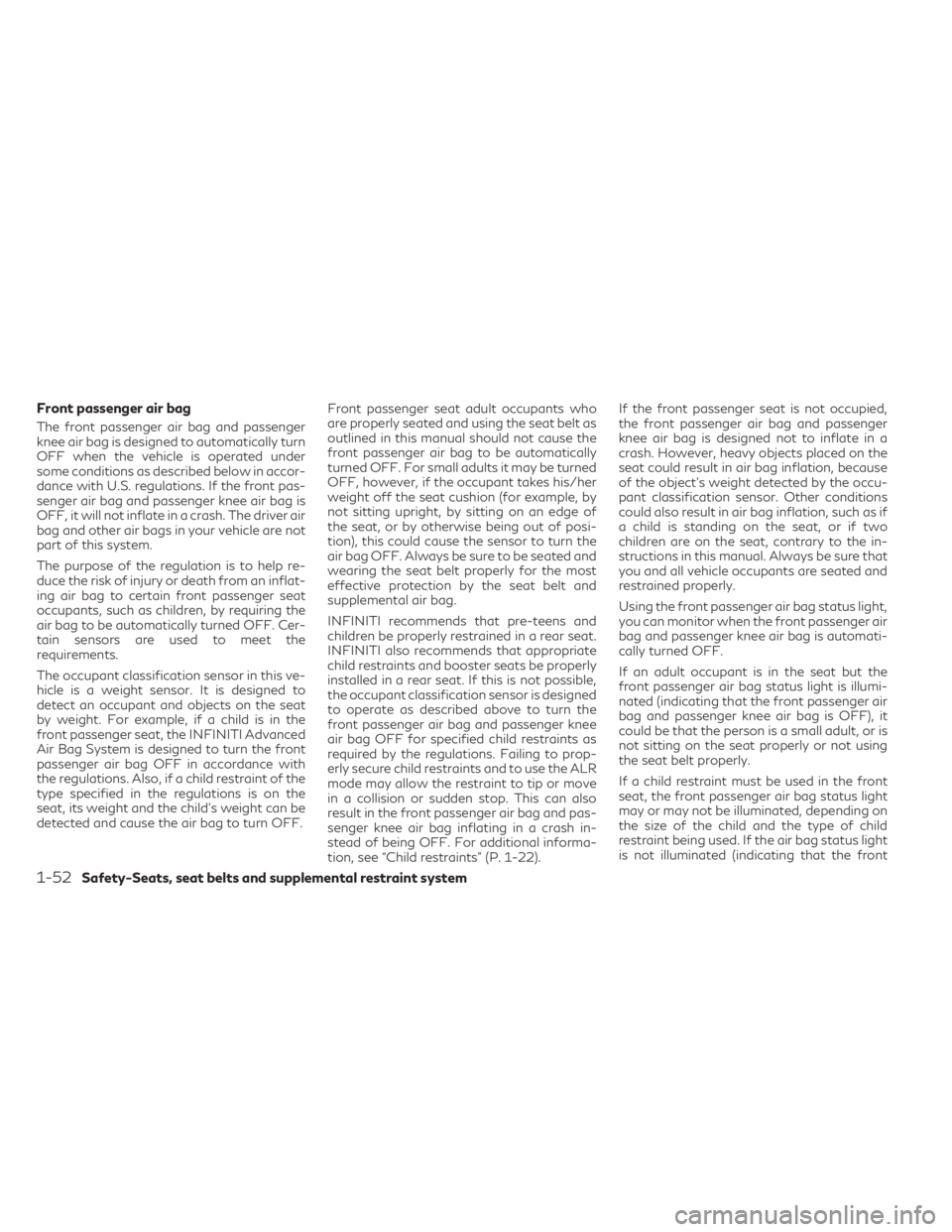
Front passenger air bag
The front passenger air bag and passenger
knee air bag is designed to automatically turn
OFF when the vehicle is operated under
some conditions as described below in accor-
dance with U.S. regulations. If the front pas-
senger air bag and passenger knee air bag is
OFF, it will not inflate in a crash. The driver air
bag and other air bags in your vehicle are not
part of this system.
The purpose of the regulation is to help re-
duce the risk of injury or death from an inflat-
ing air bag to certain front passenger seat
occupants, such as children, by requiring the
air bag to be automatically turned OFF. Cer-
tain sensors are used to meet the
requirements.
The occupant classification sensor in this ve-
hicle is a weight sensor. It is designed to
detect an occupant and objects on the seat
by weight. For example, if a child is in the
front passenger seat, the INFINITI Advanced
Air Bag System is designed to turn the front
passenger air bag OFF in accordance with
the regulations. Also, if a child restraint of the
type specified in the regulations is on the
seat, its weight and the child’s weight can be
detected and cause the air bag to turn OFF.Front passenger seat adult occupants who
are properly seated and using the seat belt as
outlined in this manual should not cause the
front passenger air bag to be automatically
turned OFF. For small adults it may be turned
OFF, however, if the occupant takes his/her
weight off the seat cushion (for example, by
not sitting upright, by sitting on an edge of
the seat, or by otherwise being out of posi-
tion), this could cause the sensor to turn the
air bag OFF. Always be sure to be seated and
wearing the seat belt properly for the most
effective protection by the seat belt and
supplemental air bag.
INFINITI recommends that pre-teens and
children be properly restrained in a rear seat.
INFINITI also recommends that appropriate
child restraints and booster seats be properly
installed in a rear seat. If this is not possible,
the occupant classification sensor is designed
to operate as described above to turn the
front passenger air bag and passenger knee
air bag OFF for specified child restraints as
required by the regulations. Failing to prop-
erly secure child restraints and to use the ALR
mode may allow the restraint to tip or move
in a collision or sudden stop. This can also
result in the front passenger air bag and pas-
senger knee air bag inflating in a crash in-
stead of being OFF. For additional informa-
tion, see “Child restraints” (P. 1-22).If the front passenger seat is not occupied,
the front passenger air bag and passenger
knee air bag is designed not to inflate in a
crash. However, heavy objects placed on the
seat could result in air bag inflation, because
of the object’s weight detected by the occu-
pant classification sensor. Other conditions
could also result in air bag inflation, such as if
a child is standing on the seat, or if two
children are on the seat, contrary to the in-
structions in this manual. Always be sure that
you and all vehicle occupants are seated and
restrained properly.
Using the front passenger air bag status light,
you can monitor when the front passenger air
bag and passenger knee air bag is automati-
cally turned OFF.
If an adult occupant is in the seat but the
front passenger air bag status light is illumi-
nated (indicating that the front passenger air
bag and passenger knee air bag is OFF), it
could be that the person is a small adult, or is
not sitting on the seat properly or not using
the seat belt properly.
If a child restraint must be used in the front
seat, the front passenger air bag status light
may or may not be illuminated, depending on
the size of the child and the type of child
restraint being used. If the air bag status light
is not illuminated (indicating that the front
1-52Safety-Seats, seat belts and supplemental restraint system
Page 99 of 542

•When replacing a wheel without the
TPMS such as the spare tire, the TPMS
will not function and the low tire pres-
sure warning light will flash for approxi-
mately 1 minute. The light will remain on
after 1 minute. Have your tires replaced
and/or TPMS system reset as soon as
possible. It is recommended that you
visit an INFINITI retailer for these
services.
• Replacing tires with those not originally
specified by INFINITI could affect the
proper operation of the TPMS.
CAUTION
• The TPMS is not a substitute for the
regular tire pressure check. Be sure to
check the tire pressure regularly.
• If the vehicle is being driven at speeds of
less than 16 mph (25 km/h), the TPMS
may not operate correctly.
• Be sure to install the specified size of
tires to the four wheels correctly.
Malfunction Indicator Light
(MIL)
If this indicator light comes on steady or
blinks while the engine is running, it may indi-
cate a potential emission control
malfunction.
The MIL may also come on steady if the
fuel-filler cap is loose or missing, or if the
vehicle runs out of fuel. Check to make sure
the fuel-filler cap is installed and closed
tightly, and that the vehicle has at least 3
gallons (11.4 liters) of fuel in the fuel tank.
After a few driving trips, the
light should
turn off if no other potential emission control
system malfunction exists.
If this indicator light comes on steady for 20
seconds and then blinks for 10 seconds when
the engine is not running, it indicates that the
vehicle is not ready for an emission control
system inspection/maintenance test. For ad-
ditional information, see “Readiness for
Inspection/Maintenance (I/M) test”
(P. 10-32).
Master warning light
When the ignition switch is in the ON posi-
tion, the master warning light illuminates if
any of the following (if so equipped) are dis-
played on the vehicle information display:
• I-Key system warnings
• Low washer fluid warning
• Door/ liftgate open warning (when vehicle is stopped)
• Loose fuel cap warning
• Low tire pressure warning
• Flat tire warning
• Transmission system warning
• Headlight warning
• Driver Attention Support system warning
• Shipping mode warning
• All Wheel Drive (AWD) system warning
• Adaptive Front lighting System (AFS) warning
• Driving Aids malfunction warning
• Chassis Control system warning
• Engine warnings
For additional information, see “Vehicle in-
formation display” (P. 2-19).
Instruments and controls2-15
Page 108 of 542
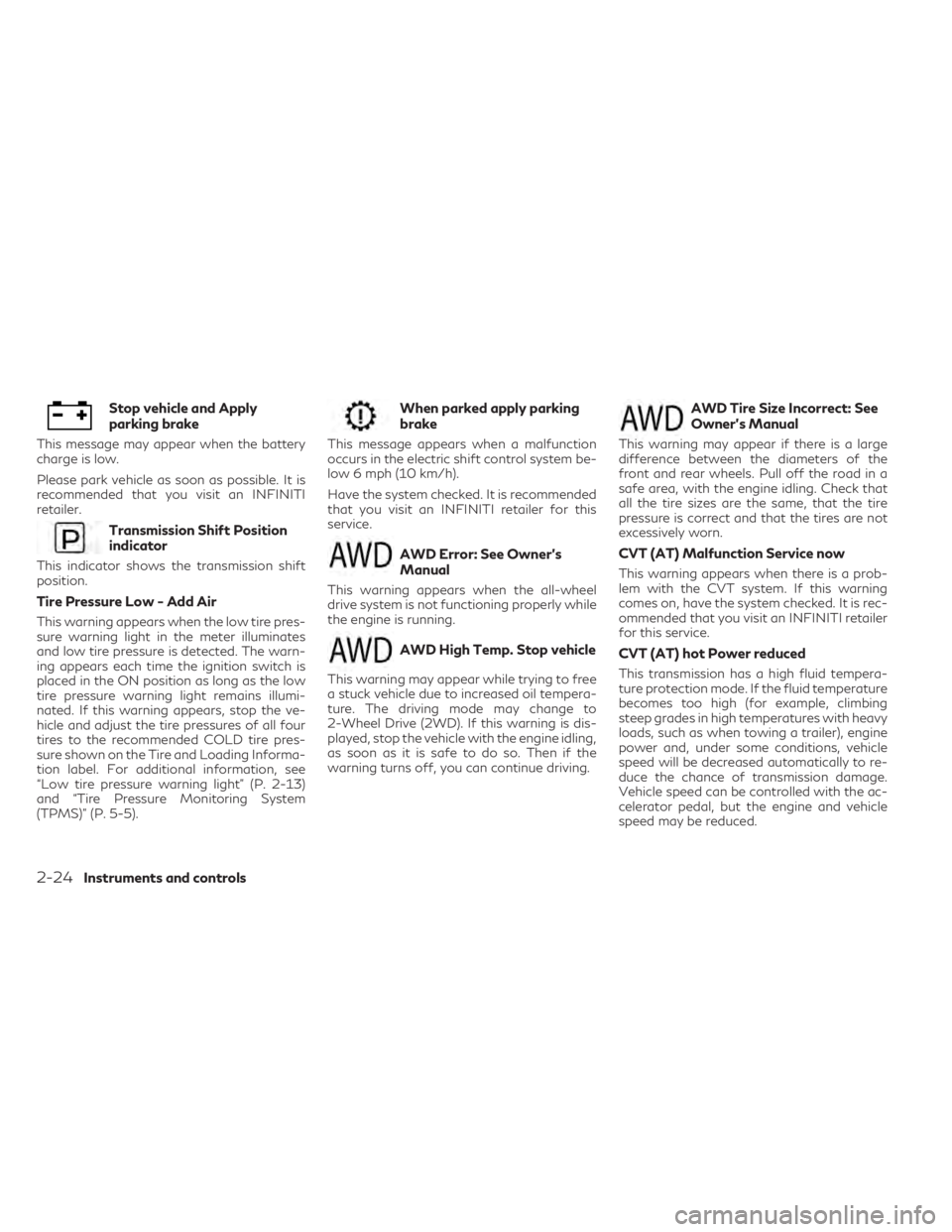
Stop vehicle and Apply
parking brake
This message may appear when the battery
charge is low.
Please park vehicle as soon as possible. It is
recommended that you visit an INFINITI
retailer.
Transmission Shift Position
indicator
This indicator shows the transmission shift
position.
Tire Pressure Low - Add Air
This warning appears when the low tire pres-
sure warning light in the meter illuminates
and low tire pressure is detected. The warn-
ing appears each time the ignition switch is
placed in the ON position as long as the low
tire pressure warning light remains illumi-
nated. If this warning appears, stop the ve-
hicle and adjust the tire pressures of all four
tires to the recommended COLD tire pres-
sure shown on the Tire and Loading Informa-
tion label. For additional information, see
“Low tire pressure warning light” (P. 2-13)
and “Tire Pressure Monitoring System
(TPMS)” (P. 5-5).
When parked apply parking
brake
This message appears when a malfunction
occurs in the electric shift control system be-
low 6 mph (10 km/h).
Have the system checked. It is recommended
that you visit an INFINITI retailer for this
service.
AWD Error: See Owner’s
Manual
This warning appears when the all-wheel
drive system is not functioning properly while
the engine is running.
AWD High Temp. Stop vehicle
This warning may appear while trying to free
a stuck vehicle due to increased oil tempera-
ture. The driving mode may change to
2-Wheel Drive (2WD). If this warning is dis-
played, stop the vehicle with the engine idling,
as soon as it is safe to do so. Then if the
warning turns off, you can continue driving.
AWD Tire Size Incorrect: See
Owner’s Manual
This warning may appear if there is a large
difference between the diameters of the
front and rear wheels. Pull off the road in a
safe area, with the engine idling. Check that
all the tire sizes are the same, that the tire
pressure is correct and that the tires are not
excessively worn.
CVT (AT) Malfunction Service now
This warning appears when there is a prob-
lem with the CVT system. If this warning
comes on, have the system checked. It is rec-
ommended that you visit an INFINITI retailer
for this service.
CVT (AT) hot Power reduced
This transmission has a high fluid tempera-
ture protection mode. If the fluid temperature
becomes too high (for example, climbing
steep grades in high temperatures with heavy
loads, such as when towing a trailer), engine
power and, under some conditions, vehicle
speed will be decreased automatically to re-
duce the chance of transmission damage.
Vehicle speed can be controlled with the ac-
celerator pedal, but the engine and vehicle
speed may be reduced.
2-24Instruments and controls